At various moments during the analysis of the Conquest-Royal game with the engines, it was noticeable that the move …cxd4 was often suggested as one of the top 3 moves. For example here:
1. b3 Nf6 2. Bb2 c5 3. e3 d5 4. Nf3 e6 5. d4 Nc6 6. Nbd2 Bd6 7. Bd3 O-O 8. O-O b6 9. a3 Bb7 10. Ne5 Rc8 11. f4
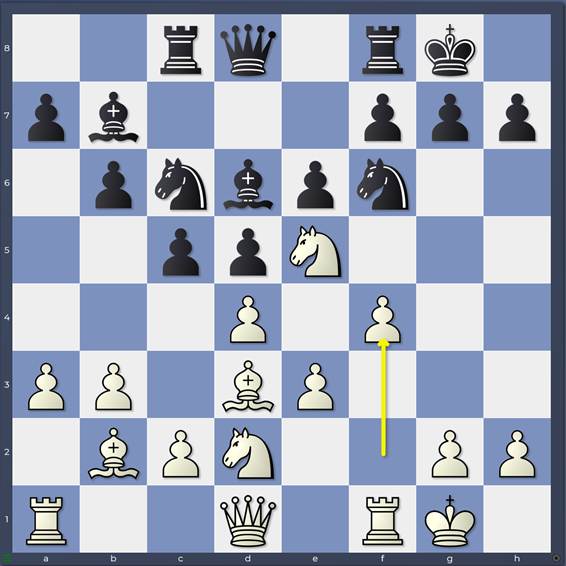
Game: 11.f4
11…cxd4 12.exd4
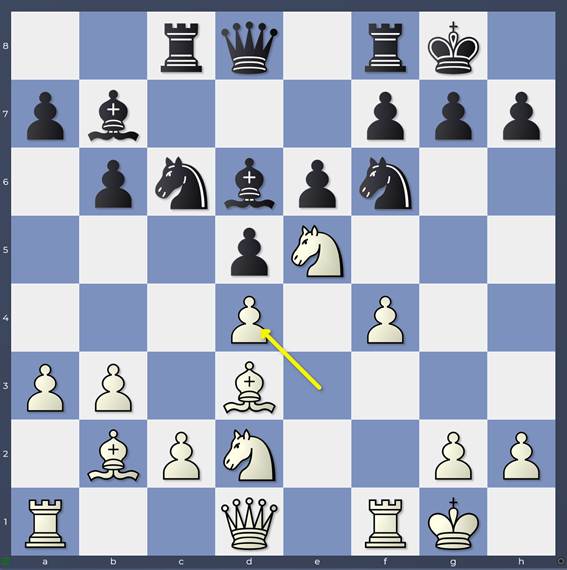
Line: 11…cxd4 12.exd4-
And here:
1. b3 Nf6 2. Bb2 c5 3. e3 d5 4. Nf3 e6 5. d4 Nc6 6. Nbd2 Bd6 7. Bd3 O-O 8. O-O b6 9. a3 Bb7 10. Ne5 Rc8 11. f4 Ne7 12.Qf3 cxd4 13.exd4
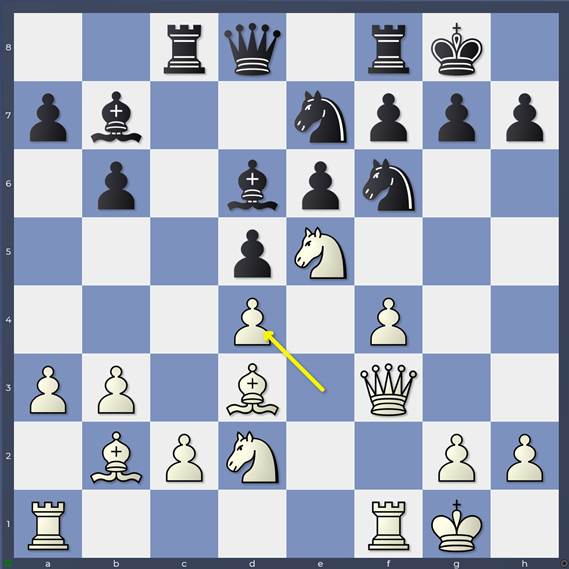
Line: 12…cxd4 13.exd4
(13.Bxd4 Nf5 is awkward for White) This is one of those things in chess for which I may need therapy to truly accept 😉 Since a young age, the books I read warned against “releasing the central tension too early” These admonitions were partly a basic warning against lazy automatic exchanges (“I can exchange something so I might as well do it”) However, they were also a more advanced warning about the finality of some decisions and the effect on your long-term possibilities. For example, in this position

Game: 11.f4
While Black hasn’t played …cxd4, he still has (for example) the possibility of …c4 (which Shreyas threatened in the game with 12…b5. Once Black plays …cxd4, he loses that possibility and White never has to pay attention to it in his plans. There is simply less for White to worry about which may make it easier for him to realise his own plans. Also, purely from an aesthetic view, moving that e3-pawn to d4 makes White’s position look more threatening! We now have an open e-file for the rook on a1, a new transfer point on e3 to bring a rook to the kingside while an attack on the e6-pawn with f4-f5 feels much more dangerous with the e-file open.
I’m therefore very suspicious of ..cxd4 ideas in general. In this specific position however, even I have to confess that capturing on d4 does have some good positional points.
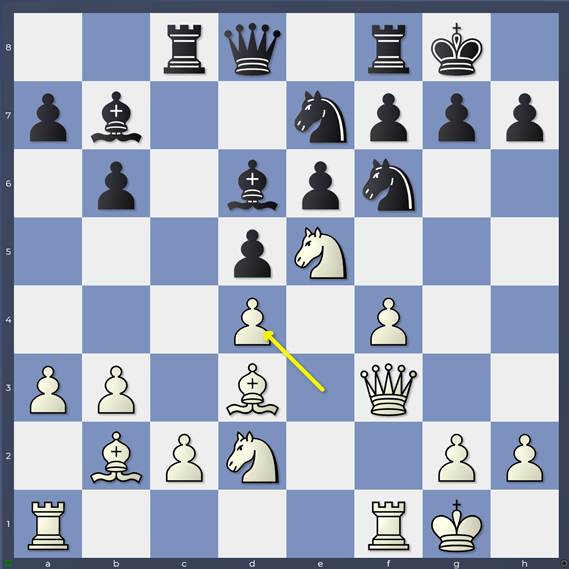
Line: 12…cxd4 13.exd4
We have seen very often that dxc5, opening the diagonal of the bishop on b2 towards the black king, can be exceptionally dangerous for Black. By fixing the central pawn structure, Black removes a dangerous attacking option for White.
Capturing on d4 also opens the c-file allowing Black to target the c3-square and also the c2-pawn opening another source of counterplay. Moves like …Ne4 as a (temporary) sacrifice are indeed more common when the black rook is already attacking the c2-pawn.
Let me just show you the game Serrano Batova – Solodovnichenko Llinars del Valles 2023 as an example:
1. d4 Nf6 2. Nf3 e6 3. e3 c5 4. Bd3 Nc6 5. Nbd2 d5 6. b3 b6 7. Bb2 Bb7 8. O-O Bd6 9. a3 O-O 10. Ne5 Rc8 11. f4 Ne7 12. Qf3
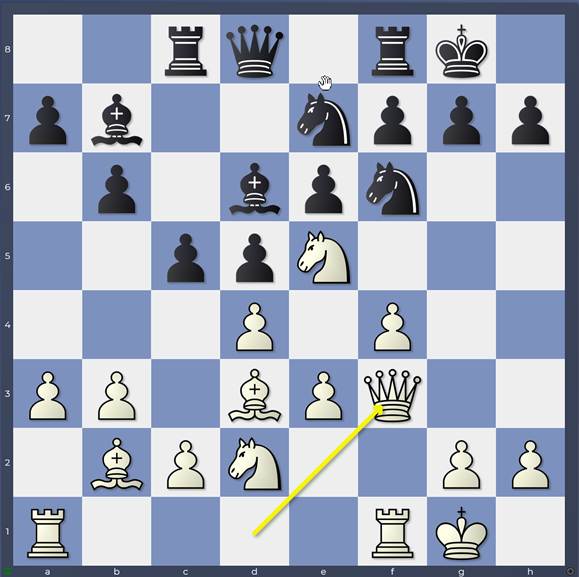
Game: Serrano Batova – Solodovnichenko after 12.Qf3
Through a more normal Colle-Zukertort move order (compared to Conquest-Royal which started with 1.b3 and then gradually transposed) we have reached our position. Here the grandmaster playing Black implemented the engine plan.
12…cxd4 13. exd4 Nf5 14. Rae1
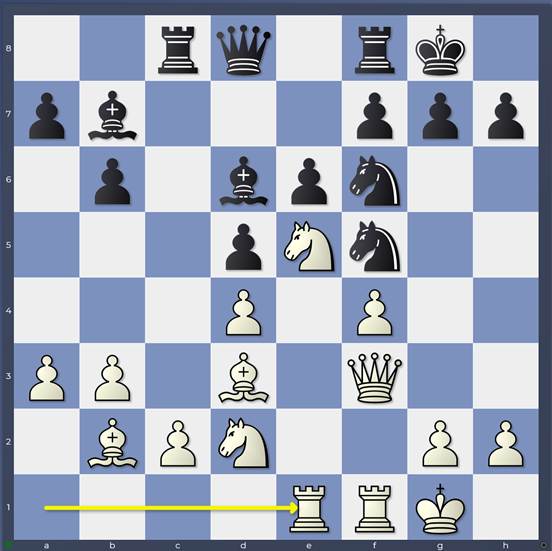
Game: Serrano Batova – Solodovnichenko after 14.Rae1
And now Black played an interesting idea, exploiting the pressure on the c2-pawn opened by …cxd4
14…Ne4 15. Nxe4 dxe4 16. Bxe4 Rxc2
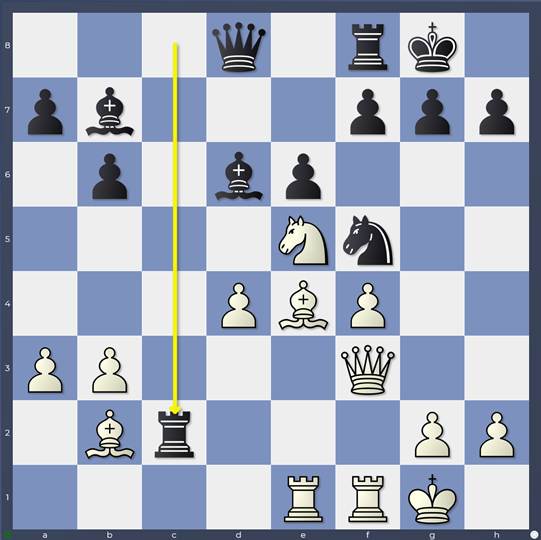
Game: Serrano Batova – Solodovnichenko after 16…Bxc2
Neatly exploiting the pin on the e4 bishop leaving Black with a clear advantage
17. Bxb7 Rxb2 18. d5 Nh4 19. Qh5 g6 20. Qh6 exd5 21. Kh1 Nf5 22. Qh3 Bxa3 23. Rd1 d4 24. Nc4 Ne3 25. Nxe3 Rxb3 26. f5 Rxe3 27. Qg4 Bc5 28. Ba6 h5 29. Qf4 g5 30. Qf2 Qf6 31. Bc4 d3 32. Qa2 Qe5 33. Rxd3 Bd6 34. g3 Re2 0-1
[Digression. By the way, if you’re wondering what White should have played after 14…Ne4, the best idea is to play 15.Nxe4 dxe4 16.Rxe4
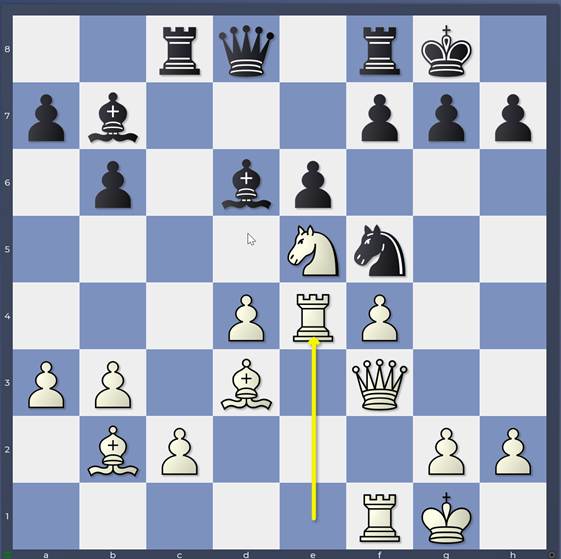
Line: Serrano Batova – Solodovnichenko after 16.Rxe4
These exchange sacrifices are quite common in the Colle-Zukertort and normally give White good practical chances. It made me think of a position I saw from the 4NCL which actually turned out to be this opening when I looked it up!
Fodor, Tamas Jr – Gormally, Daniel 4NCL 2019-2020
1. d4 Nf6 2. Nf3 e6 3. e3 d5 4. Bd3 c5 5. b3 Nc6 6. Bb2 Bd6 7. O-O O-O 8. a3 b6 9. Nbd2 Bb7 10. Ne5 Qc7 11. f4 Ne7
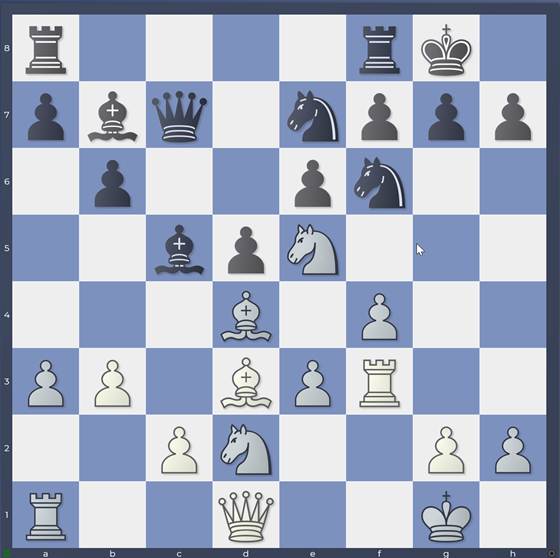
Game: Fodor, Tamas Jr – Gormally, Daniel after 11…Ne7
And now Tamas played the caveman-y
12. Rf3
Which was answered sharply by
12…c4
After which White was forced to sacrifice the exchange with
13. bxc4 dxc4 14. Ndxc4
The engines prefer 14.Nexc4
14…Bxf3 15. Qxf3
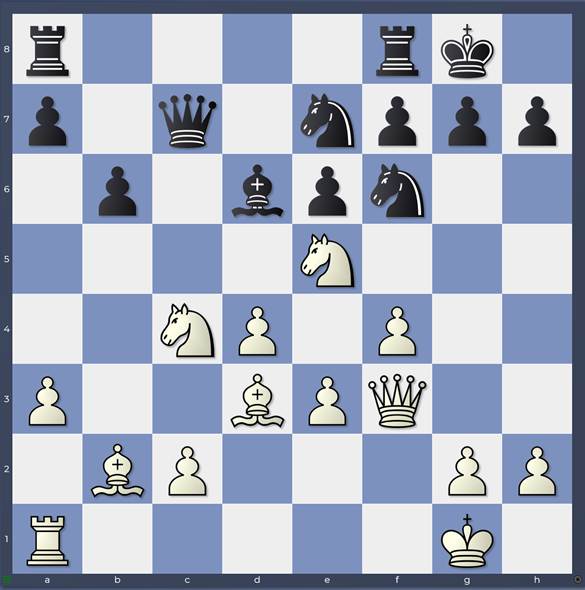
Game: Fodor, Tamas Jr – Gormally, Daniel after 15.Qxf3
Although the engines assess the position as equal, I think it’s more pleasant for White to play. That solid centre makes Black feel it’s impossible to “hurt” White in any way, and meanwhile White has obvious plans of launching something on the kingside.
15…Ng6 16. Rf1 Be7 17. G4 b5 18. Nxg6 hxg6 19. Ne5 Bd6 20. F5 exf5 21. Gxf5 g5 22. Qg2 Rae8 23. Qxg5 Rxe5 24. Dxe5 Bxe5 25. Bxe5 Qxe5 26. Rf3 Rb8 27. Rg3 Nh7 28. Qh4 Qf6 29. Qf4 Rc8 30. Kg2 a6 31. A4 Rc5 32. Qe4 Re5 33. Qa8+ Nf8 34. Axb5 axb5 35. Qb7 Rxf5 36. Bxf5 Qxf5 37. Qc6 Ng6 38. E4 Nh4+ 39. Kg1 Qf4 40. Qe8+ Kh7 41. Qxb5 f5 42. Qb2 Nf3+ 43. Kh1 Ng5 44. Qd4 1-0
End of Digression]
Finally, (apologies for that extended digression), capturing on d4 does nothing to inhibit Black’s standard plan of establishing a grip on the e4-square (for example with …Nf5-d6 (after moving the bishop) and Nf6-e4 followed by …f6 driving away the knight from e5.
So I might be able to agree that …cxd4 has a lot of point even if stylistically, I’d probably prefer to wait as long as possible before playing it! In general, I think strong players tend to rate their ability to navigate complexity and deal with multiple options at every move as higher than normal and I tend to like their chances in such situations (at least that’s how I’ve always played).
I think that probably reflects the feeling of most of my colleagues too judging from the statistics:
After 11. f4
11…Ne7 was played 252 times in my database
11…cxd4 was played just 18 times
After 11.f4 Ne7 12.Qf3
A move like 12…b5 (as in the game) was played 59 times in my database
12…cxd4 was the fifth most popular move at 7 times.
Let me just round this off by showing a few example of engine games after 11.f4 Ne7 12.Qf3 cxd4 13.exd4 to give you a taster of how the engines create play with Black:
Example 1:
13…Nf5 14.g4
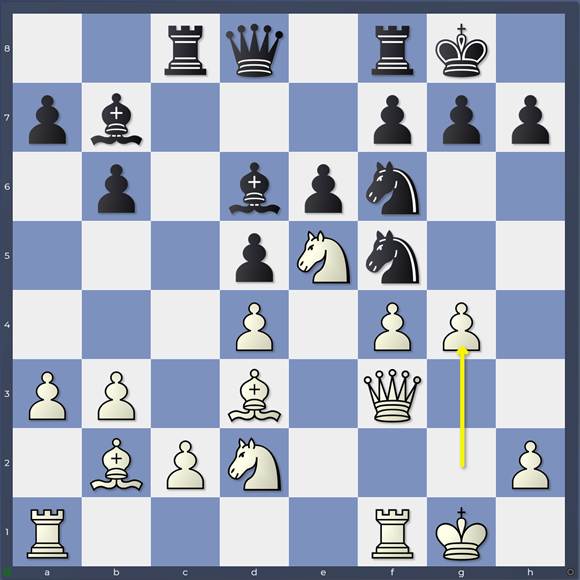
Line: 14.g4
My move of course! The engines are very dismissive of it (-0.9) but still manage to hold some draws as White. The key point is that the black knight doesn’t seem to have any worries about being out on a limb on h4!
14…Nh4 15.Qh3 Ne4 16.Rad1 Rc7

Line: 16…Rc7
A very common and flexible move from the engines. Black is ready at a moment’s notice to double on the c-file, either with the queen on c8 (knight on h4 permitting) or the rook with possibilities of an exchange sacrifice on c2 in the air.
17.Bc1
Looking to eject the knight on e4 with Rde1
17…Qe7
Hitting the pawn on a3 (not en prise yet because of the loose knight on h4) and preparing to double up on the c2-pawn with …Rfc8
18.Rde1 f5
c
Line: 18…f5
Nailing in the knight on e4 with a clear advantage Torch-Stockfish Matthew Engine Games 2025 (0-1, 82)
Example 2:
13…Nf5 14.c3
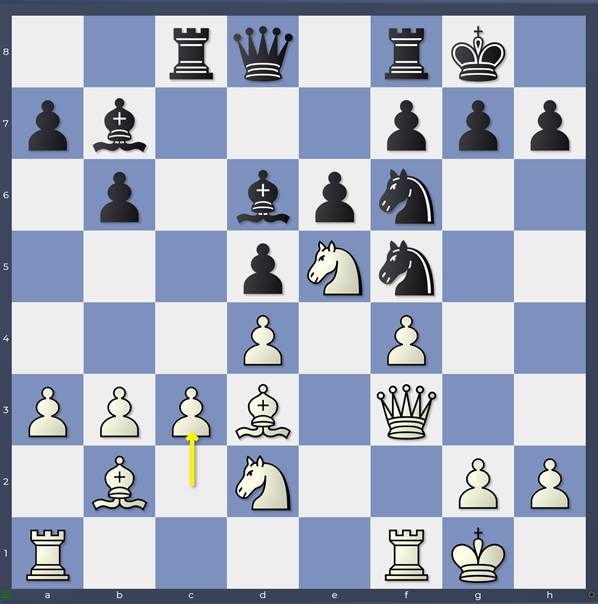
Line: 14.c3
The solid and sensible engine move, removing …Ne4 tricks by putting the pawn on a dark square. However, surely that makes you feel better about playing …cxd4 when you see what White has had to do to his poor dark-squared bishop on b2!
14…Rc7 15.a4 Be7 16.Rae1 Qc8
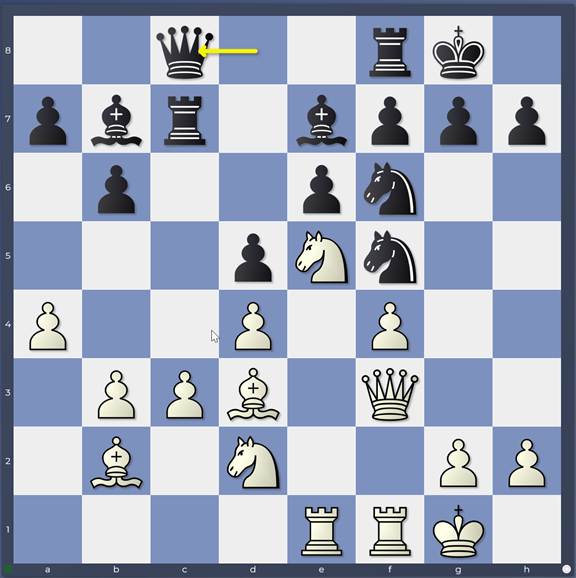
Line: 16…Qc8
Three very nice moves from Black, marshalling its pieces beautifully. …Be7 allows …Nd6 targeting the e4-square, …Qc8 prepares …Ba6 exchanging off White’s light-squared bishop both removing an attacking resource and a defender of the e4-square.
17.Qh3 Ba6 18.Bxa6 Qxa6 19.g4 Nd6 20.Ba3

Line: 20.Ba3
White also reacts very nicely, seizing its opportunities to gain space on the kingside and to activate the passive bishop on b2. The game concluded in an early draw as follows:
20…Qc8 21. c4 Qd8 22. f5 exf5 23. g5 Ng4 24. Nxg4 fxg4 25. Qxg4 Nc8 26. Bxe7 Nxe7
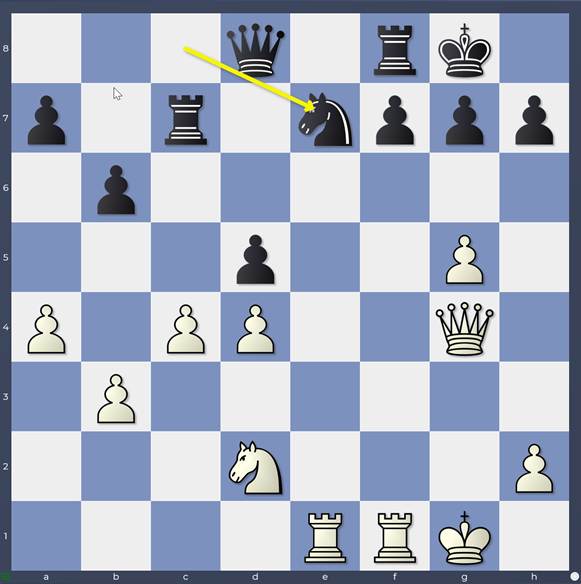
Line 26…Nxe7
0.00 for engines but still a tight game for us humans!
That rounds off our coverage of the Conquest-Royal game and this variation of the Colle-Zukertort. I hope that it’s proved interesting and stimulates you to try out these lines with both colours!


